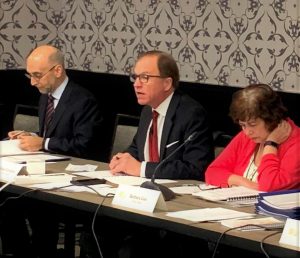(Originally published in the Spring 2019 issue of The Insurance Receiver and is reprinted with the permission of IAIR)
On January 1, I began a one-year term as Chairman of the International Forum of Insurance Guarantee Schemes (IFIGS). My colleague at NOLHGA, Peter Gallanis has been involved since the earliest days of IFIGS and I joined him a few years ago.
The objectives of the Forum are to facilitate and to promote international cooperation between Insurance Guarantee Schemes and other stakeholders in the development of policyholders’ protection. From time to time it may communicate views, ideas and experiences to interested parties. IFIGS is a voluntary not for profit membership network. It is independent of any government authority. Currently there are twenty-five members and the membership is growing.
I took on this responsibility because of my very strong sentiment that the insurance industry is absolutely essential to the world economy. The insurance promise makes opportunity a possibility. Our support of it keeps the industry strong and gives comfort and peace of mind to policyholders. Guaranty mechanisms ready to protect insurance consumers undergird the sanctity of the insurance promise by assuring the viability, commitment and reputation of the insurance industry.
IFIGS is well-positioned to be the global definitive expert on supporting the insurance promise. All protections do not have to be structured the same way, but the important role of policyholder protection mechanisms must be articulated clearly and effectively to regulators as they work as overseers of the global insurance industry.
To build the value of the organization, IFIGS members have set three long-term strategic objectives:
- Information Sharing. IFIGS will collect information and be the global expert regarding insurance guarantee schemes and will be an active resource for IFIGS members, supervisors and standard-setters.
- Member Outreach. IFIGS will develop a plan for actively recruiting new members and encouraging more active participation and leadership by existing members.
- Reputation Enhancement. IFIGS will work to heighten its profile with supervisors and standard setters, including those that may be involved in developing new insurance guarantee schemes.
Examples of IFIGS effectiveness are not hard to find:
1. The consultation paper published by the IAIS in mid-November, 2018 concerned a proposed holistic framework for the assessment and mitigation of systemic risk in the insurance sector. The initial IAIS consultation included the following statement:
“In addition to the direct economic effects of an insurer’s failure to pay claims on consumption, by a reduction of policyholders’ wealth, a number of correlated failures could have additional knock-on effects, such as through some insurance guarantee schemes.”
IFIGS, in partnership with NOLHGA and NCIGF, commented on the consultation paper and strongly objected to that statement. The offending comment was removed from the revised paper.
It would have been nothing short of a disaster for global regulators to continue their consideration of approaches to insurer oversight if they believed that policyholder protection schemes could spread contagion! It could take decades to change that thinking and no one country could do that alone. But by working together, IFIGS and its members played a strong advisory role that regulators took seriously. That is the value of being collaborative and building on that strategy.
2. A July 2017 paper published by EIOPA (European Insurance and Occupational Pensions Authority) stated that a minimum degree of harmonization of policyholder protection schemes in the European Union would benefit policyholders, the insurance market and the financial stability of the EU. IFIGS was invited to present on the role that insurance guarantee schemes can play in resolution during an EIOPA recovery and resolution seminar.
Thanks to our active participation in IFIGS, the U.S. made a joint presentation (with Greece) to an audience of European regulators and companies, and our presentation drew more interest from the audience than any other presentation over the day and half seminar. From this experience it was confirmed what we had already learned; that European regulators are very curious about our state-based system of policyholder protection. As EIOPA continues to deliberate on harmonization, the background we provided should prove useful.
3. Finally, on another occasion, Peter Gallanis and I, joined by a colleague from Canada, were asked to represent IFIGS before a working group of international regulators (including James Kennedy from the Texas DOI and Alex Hart from the Federal Insurance Office) who were drilling down on the relationship between regulators and policyholder protection mechanisms. My understanding is that we were helpful in providing background on ways to collaborate to provide a more effective safety net to consumers.
A primary goal is to spread the value of our engagement with IFIGS to IAIR and the NAIC. And to take that back to the IFIGS membership and international regulators. Our resolution mechanism—composed of receivers and guaranty funds– is by far the most experienced and effective system in the world. The broader the expertise we can bring to the table, the more impactful we can be on behalf of the individual policyholders and claimants we serve.
For more on particulars of other mechanisms around the world, a good, but not definitive, resource is a discussion paper published by EIOPA. https://eiopa.europa.eu/Publications/Consultations/EIOPA-CP-18-003_Discussion_paper_on_resolution_funding%20and.pdf)
I am happy to discuss this organization and the value of the United States’ participation. Please feel free to contact me.
Further information may also be obtained from the IFIGS website at www.ifigs.org.

